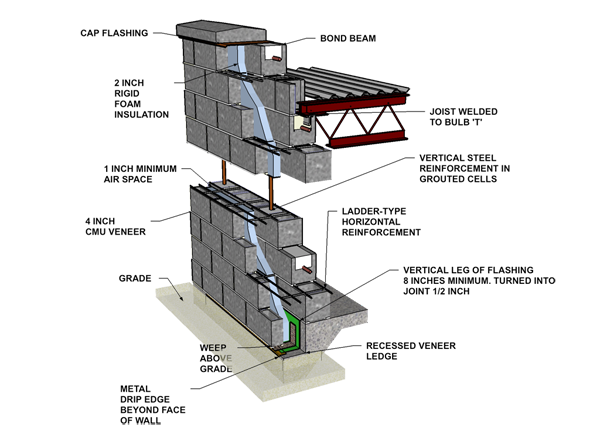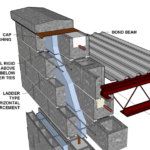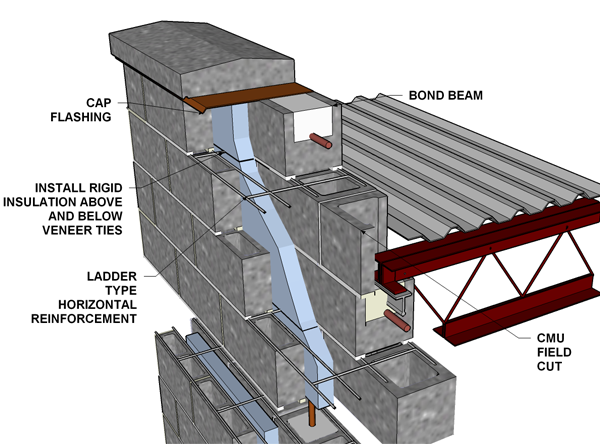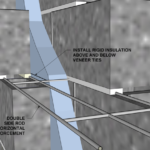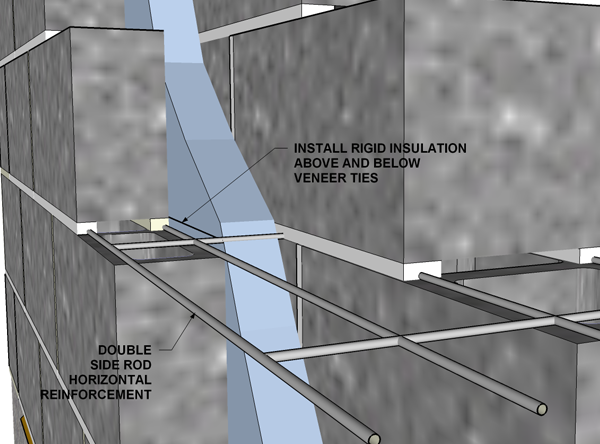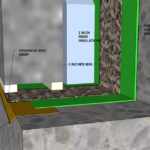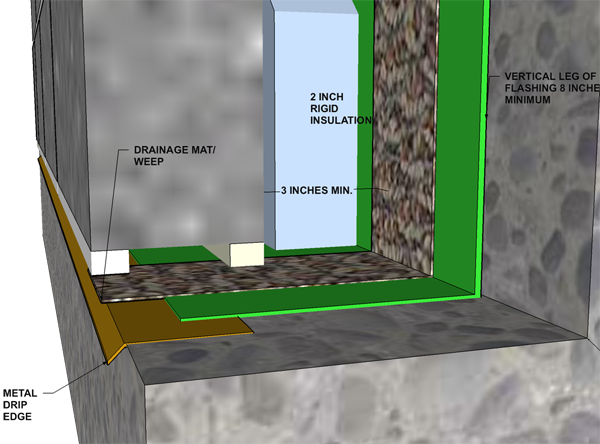Concrete Block Veneer / Reinforced Concrete Block
Recommended Building Types
- Schools, commercial, industrial and institutional buildings
- Buildings requiring a high fire rating
- Noisy environments
- Areas with frequent rainfall
- Choosing the Right Masonry System for your Budget
Benefits
- Most economical of all the masonry cavity wall systems
- Tough, beautiful concrete block exterior over a structural concrete block backup system
- Durable and long-lasting
- Minimal long-term maintenance
- Good design flexibility, with many different colors, textures and bond patterns available
- Concrete block backup acts as the structure, with vertical and horizontal reinforcement grouted into place
- Cavity system inherently weatherproof – great for moist environments
- Excellent insulating value and heat capacity
- Fire proof with fire ratings up to 4 hours.
- Great for noisy environments – naturally absorbs sound
- One trade erects both the structural and skin layers of the wall
Special Considerations
- Lower life cycle cost offsets somewhat higher initial investment
- This substantial wall system may require larger foundation
Definition and Assumptions
Backup: Lightweight plain gray concrete block (CMU), 8″ x 8″ x 16″ (nom.)
Reinforcement: #6 vertical reinforcement at 32″ on center. 9-gauge joint reinforcement at 16″ o.c. (every other course)
Veneer: Lightweight plain face gray concrete block veneer (CMU), 8″ x 4″ x 16″ (nom.)
Cavity: 3″ air space
Insulation: 2″ rigid expanded polystyrene in drainage cavity
Reinforcement: 9-gauge joint reinforcement at 16″ o.c. (every other course)
Flashing: base Flashing and weeps
Veneer ties: double side rod tri-rod joint reinforcement @ 16″ o.c.
Mortar: Type N, Portland cement/lime, plain gray
Joints: concave tooled
Regional Variations
- When masonry veneer is used in areas of high seismic risk, Veneer ties are required to attach to wire reinforcement embedded in Mortar bed joints in the veneer. Check your local requirements – and save money by using normal Veneer ties in areas of low seismic risk.
- Many areas of the western U.S. have good local sources for lightweight aggregate, and the use of lightweight concrete block (CMU) is the norm. In other parts of the country, medium weight and normal weight block are more common.
- Structural masonry walls in areas of high seismic risk are required to have additional horizontal bond beams to resist seismic loads. Check with your structural engineer to determine what is required in your region.
- The use of reinforced bond beams can replace the necessity for joint reinforcement in concrete masonry walls. Understand that some form of horizontal reinforcement is required in all concrete masonry construction, including veneer applications.
Fire Rating (hours)
Ungrouted Assembly: 4 hrs
Fully grouted Assembly: 4 hrs
Sound Transmission Class (dB)
Ungrouted: 52.0
Grouted 32″: 54.4
Fully grouted: 59.6
STC=(weight of wall) 0.223x21.5
Wall Weight (lb/sq. ft.)
Ungrouted: 53 lb/sq. ft
Grouted 32″: 64 lb/sq. ft
Fully grouted: 97 lb/sq. ft
Energy Rating
R-value: 12.5 using 2″ expanded polystyrene insulation (see note below)
Calculation:
| Outside Air | =0.17 |
| 4 inch CMU | =1.19 |
| Air Gap | =0.97 |
| 2 inch Polystyrene | =8.00 |
| 8 inch CMU 105 pcf, grouted at 32″ o.c. | =1.45 |
| Interior Air | =0.68 |
| Total | =12.46 |
- R-Value/U-Factor Calculator (configurable)
- R-Values of Multi-Wythe Concrete Masonry Walls
- Introduction to Energy Performance of Brick Masonry
Note: The type of rigid insulation you install affects the wall’s insulating capacity (the R-value). Polyisocyanurate insulation gives you 8.0 R per inch (12.0 R for 1.5″ or R16 for 2″). Expanded polystyrene insulation is worth 4.0 R per inch (6.0 R for 1.5″ or 8 R for 2″). Extruded polystyrene yields 5.0 R per inch (7.5 R for 1.5″ or 10 R for 2″). Use either thicker insulation or more expensive polyisocyanurate to achieve a higher energy rating.
Sustainability & LEED
- Energy efficiency, thermal comfort and energy analysis – up to 10 pts
- Innovation and design – 1 pt
- Recycled content – 2 pts
- Regional material (where applicable) 2 pts
- Renewable energy and thermal mass – up to 10 pts.
- Concrete Masonry and the LEED Program
- Determining the Recycled Content of Concrete Masonry Products
- Sustainablility and Brick
Design Tips
- Place rigid-board insulation in the drainage cavity to maximize interior usable space, and take advantage of the huge thermal mass provided by the masonry backup system.
- Consider including water repellent coating on the concrete block (CMU) veneer. The structural 8″ CMU wall does not need water repellent because it is not exposed to weather.
- Concrete block shrinks over time. Don’t forget to detail control joints in the concrete block backup and the veneer to minimize the potential for shrinkage cracks.
- Concrete masonry is more porous than brick – make sure the drainage cavity is detailed properly to keep water out of the building.
- Untreated concrete masonry is too porous to use as a sill or coping. Use specially manufactured wall cap units, cast stone, or metal sills and copings.
- shelf angles may not be required for veneer support at every floor line. Cut down on the number of shelf angles to save money and simplify your construction. If your veneer is shorter than 30 feet above the top of the foundation wall, you may not need relieving angles at all.
Construction Tips
- Remember to always use joint reinforcement in concrete masonry to help control shrinkage cracks – even in concrete masonry veneer.
- Back bevel Mortar joints to help keep excess Mortar from falling down and clogging the drainage cavity.
- Simplify construction by requesting to use the same Mortar type on the veneer as the backup. Type N is usually fine for both, except in high seismic zones where Type S is required.
